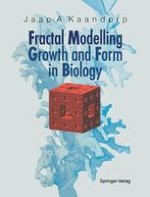1994 | OriginalPaper | Buchkapitel
2D Models of Growth Forms
verfasst von : Jaap A. Kaandorp
Erschienen in: Fractal Modelling
Verlag: Springer Berlin Heidelberg
Enthalten in: Professional Book Archive
Aktivieren Sie unsere intelligente Suche, um passende Fachinhalte oder Patente zu finden.
Wählen Sie Textabschnitte aus um mit Künstlicher Intelligenz passenden Patente zu finden. powered by
Markieren Sie Textabschnitte, um KI-gestützt weitere passende Inhalte zu finden. powered by
This chapter discusses how a system of rules can be created, as shown in the section on the ramifying objects, suitable for the simulation of the growth process of various sessile marine organisms, for example sponges (Porifera) and corals (Scleractinia). A crucial difference with the example of the ramifying objects is that each modelling step is supposed to have a biological significance. An important reason to use sponges and corals as subjects of a case-study is that these organisms exhibit a relatively simple growth process, which makes it comparatively easy to design geometric production rules to simulate growth processes. Although the marine sessile organisms belong to many very different taxonomic groups, it is possible to distinguish several types of corresponding growth processes within these groups, in which a similar architecture emerges. First almost all groups belong to the large group of modular organisms. In this group there is a subset of organisms which are formed by one type of growth process, which will be discussed in particular in the next sections. This growth process can be found within sponges, stony corals and many other marine sessile organisms and will be indicated as radiate accretive growth. Modular growth and radiate accretive growth are the first subjects in this chapter, followed by a 2D model of radiate accretive growth.
